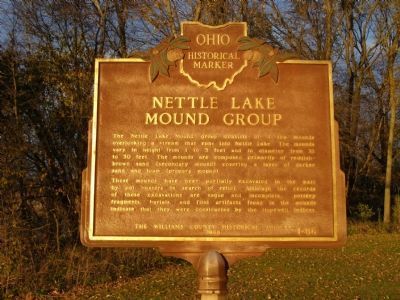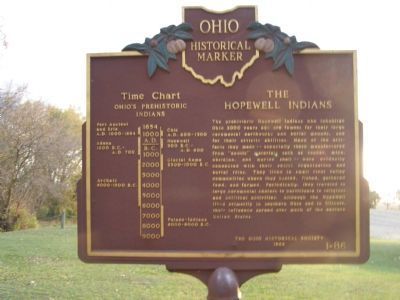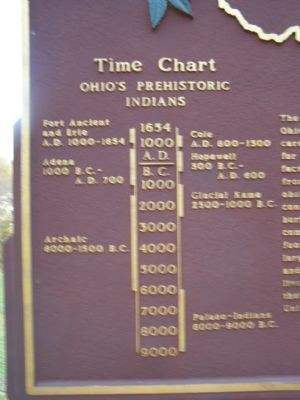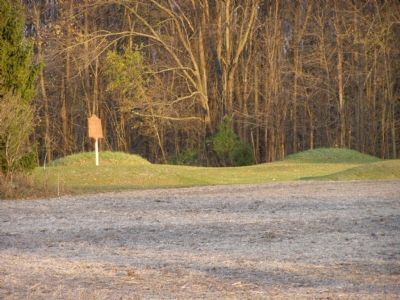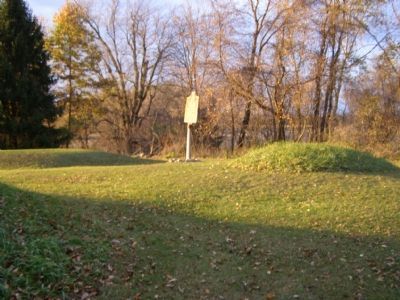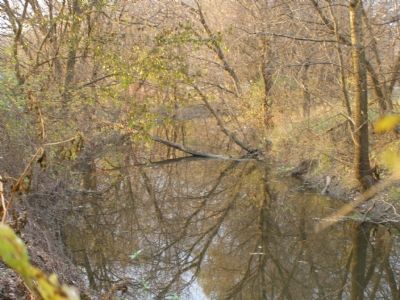Montpelier in Williams County, Ohio — The American Midwest (Great Lakes)
The Nettle Lake Mound Group
The Nettle Lake Mound group consists of 4 low mounds overlooking a stream that runs into Nettle Lake. The mounds vary in height from 1 to 3 feet and in diameter from 18 to 3- feet. The mounds are composed primarily of reddish-brown sand (secondary mound) covering a layer of darker sand and loam (primary mound).
These mounds have been partially excavated in the past by pot hunters in search of relics. Although the records of these excavations are vague and incomplete, pottery fragments, burials, and flint artifacts found in the mounds indicate that they were constructed by the Hopewell Indians.
(Reverse): The Hopewell Indians
The prehistoric Hopewell Indians who inhabited Ohio 2000 years ago are famous for their large ceremonial earthworks and burial mounds, and for their artistic abilities. Many of the artifacts they made - - especially those manufactured from 'exotic' materials such as copper, mica, obsidian, and marine shell - - were evidently connected with their social organization and burial rites. They lived in small river valley communities where they hunted, fished, gathered food, and farmed. Periodically, they traveled to large ceremonial centers to participate in religious and political activities. Although the Hopewell lived primarily in southern Ohio and in Illinois, their influence spread over much of the eastern United States.
Erected 1968. (Marker Number 1-86.)
Topics and series. This historical marker is listed in these topic lists: Cemeteries & Burial Sites • Man-Made Features • Native Americans. In addition, it is included in the Ohio Historical Society / The Ohio History Connection series list. A significant historical year for this entry is 2000.
Location. 41° 41.194′ N, 84° 43.887′ W. Marker is in Montpelier, Ohio, in Williams County. Marker is on County Road 475, one mile County Road R. North of the Ohio Turnpike on S.R. 49. Turn east (right)onto C.R. R to C.R. 475. North 1 mile. Touch for map. Marker is in this post office area: Montpelier OH 43543, United States of America. Touch for directions.
Other nearby markers. At least 8 other markers are within 7 miles of this marker, measured as the crow flies. Copperbelly Water Snake Habitat Restoration (approx. one mile away); Where Indiana, Michigan, and Ohio Meet (approx. 3.9 miles away in Michigan); Chester Park Veterans Memorial (approx. 5 miles away in Michigan); Camden Cemetery Veterans Memorial (approx. 5 miles away in Michigan); First Millstone Used in Mill (approx. 5˝ miles away); Indiana's Northern Boundary Line (approx. 6˝ miles away in Indiana); Powers Memorial (approx. 6.6 miles away in Indiana); Powers Church (approx. 6.6 miles away in Indiana).
More about this marker. On the left half of the reverse side of this marker is a timeline of Ohio's Indian History. A closeup of this timeline is provided in picture 3.
Also see . . . Hopewell Culture: 100 B.C. to A.D. 500. Ohio History Central article, published July 1, 2005. (Submitted on December 7, 2007, by Kevin W. of Stafford, Virginia.)
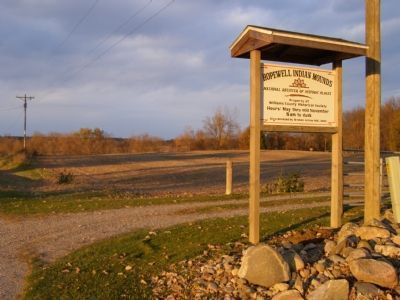
Photographed By Christopher Light, November 4, 2007
6. Hopewell Indian Mounds
National Register of Historic Places
Property of Williams County Historical Society
Hours: May thru mid November
8 am. to dusk
Sign donated by Broken Arrow M.C. 2004
Note: there is a farm field between the entrance and the park. If planted in corn, the park and marker will not be visible from the road.
Property of Williams County Historical Society
Hours: May thru mid November
8 am. to dusk
Sign donated by Broken Arrow M.C. 2004
Note: there is a farm field between the entrance and the park. If planted in corn, the park and marker will not be visible from the road.
Credits. This page was last revised on June 16, 2016. It was originally submitted on December 6, 2007, by Christopher Light of Valparaiso, Indiana. This page has been viewed 7,751 times since then and 278 times this year. Photos: 1, 2, 3, 4, 5, 6, 7. submitted on December 6, 2007, by Christopher Light of Valparaiso, Indiana. • Kevin W. was the editor who published this page.
